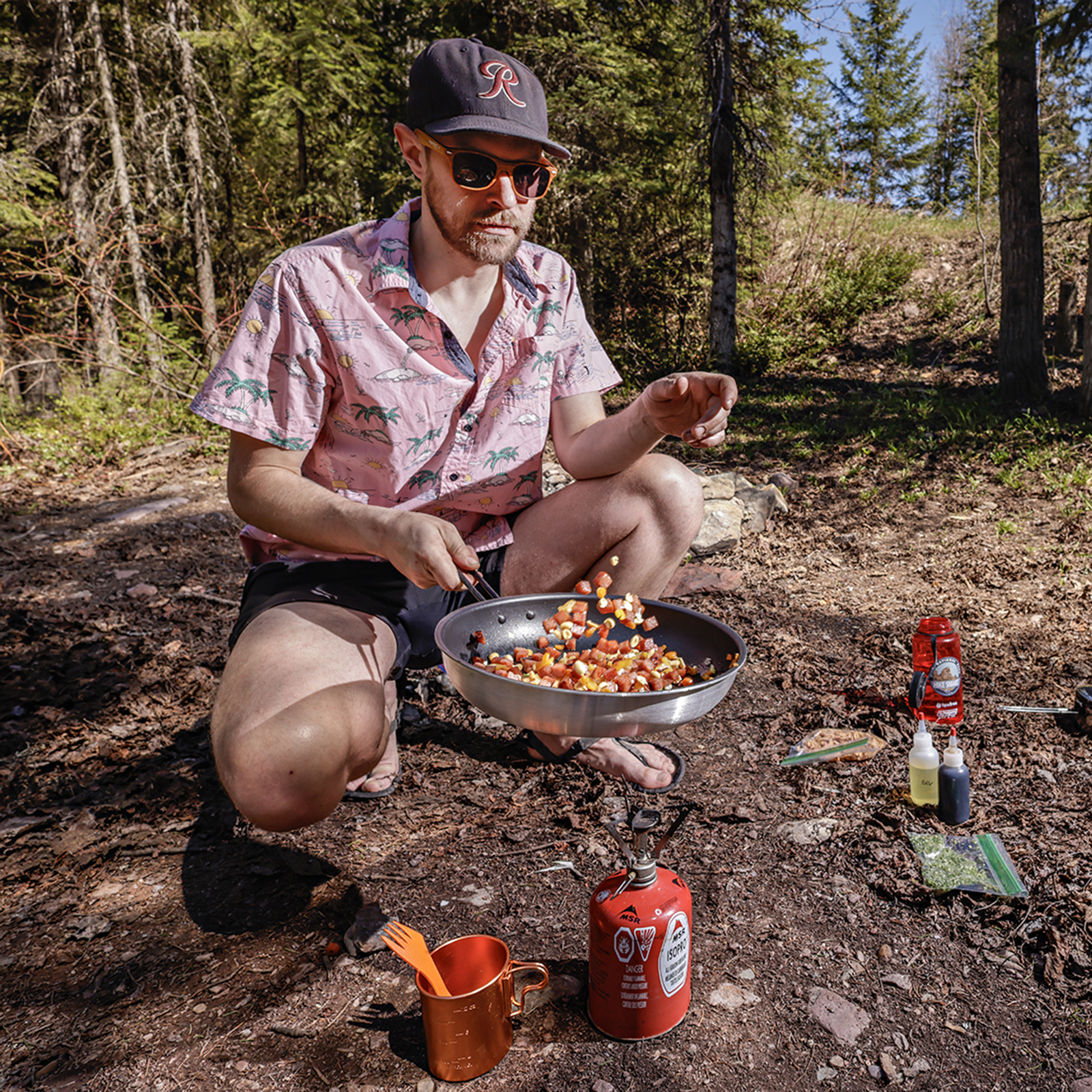
During a summer camping trip in northwest Montana’s backcountry, there typically comes a time during the sun’s long descent across the sky when the beauty of the day — or perhaps its brutality —starts to transmute into memory, and filling an empty stomach becomes life’s great priority.
Miles away from home and any number of leg-burning incline ascents away from the trailhead, ordering a pizza isn’t an option, a refrigerator is more of a concept than an object, and an evening of fine dining, or even not-so-fine dining, seems a galaxy away.
But while the experience of eating and cooking in the backcountry is limited by circumstance, that doesn’t mean that it has to begin and end with a grim scene of just-add-water gorging on prepackaged backpacking meals and protein bars. For years now, Dan Moe, a professional chef and culinary school instructor who lives in Columbia Falls, has been trying to transcend the sodium-laden inevitability of ready-to-eat meals, without ditching his passion for exploring some of Montana’s wildest places.
Moe, who most recently worked at Flathead Valley Community College’s Culinary Institute of Montana as an instructor, has expertise in a wide range of culinary methods and traditions, ranging from baking (he was the first professional bread baker hired by Whitney Brien to join her at Fleur Bakery in Whitefish), to traditional French cooking, to the ins-and-outs of American Chinese takeout. He’s even taught classes on backcountry cooking through FVCC’s continuing education program.
A seasoned backcountry hiker, camper and forager who has undertaken a variety of outdoor adventures, including those of the ultralight variety, Moe has used his days on the trail and nights in the wild to develop recipes and techniques that allow his professional expertise to enhance his time in the outdoors.
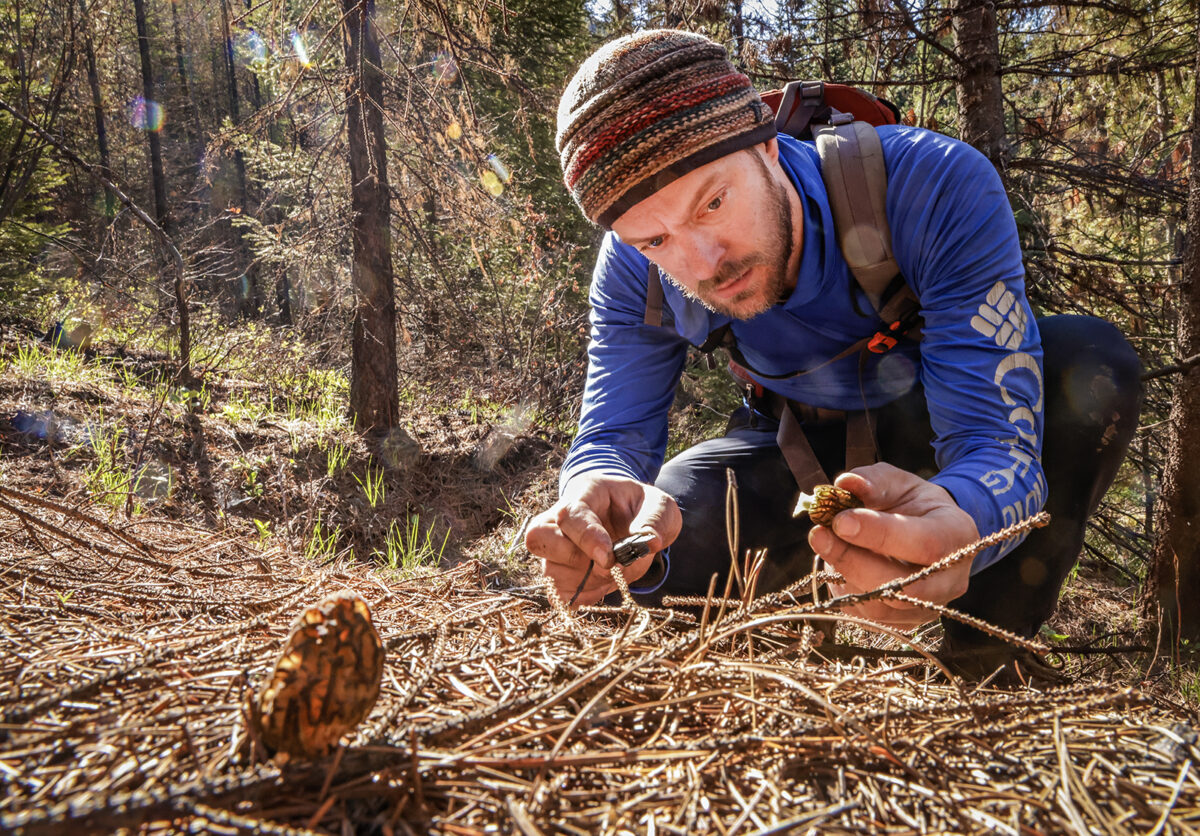
There are a number of reasons why he advocates for people doing their own cooking in the backcountry. The flavor is generally going to be better once you’ve got a seasoned, or, at least, friendly hand calling the shots. And there’s a way in which the process, intentionality, and ritual of cooking lends the backcountry camping experience a little more depth of meaning. But perhaps the greatest selling point begins with your wallet.
For example, Mountain House, which produces a wide variety of prepackaged camping and backpacking meals, charges something on the order of $11 for a two-serving container of chili mac with beef. If you break it down to a cost-per-serving level, that’s around $5.50. Moe’s version of chili with quinoa, which is a product of his ultralight days, and in its most basic form involves dehydrating and then rehydrating canned chili and quinoa, comes out to something in the order of $2 per serving in its most basic form. In other words, an enterprising dirtbag could cut their food costs in half with a little planning and extra work.
“That’s a big reason,” Moe said of the cost savings, before turning it back to the more experiential, emotional side of things. “Very rarely am I so tired at the end of a day of backpacking that I just want to crash. So, it’s good to have something to do to kind of unwind, move around a little bit here and there to get relaxed for the evening. The ceremony of it is a big part of it, with everybody gathered around.”
Moe, who is originally from Washington State, said that he didn’t grow up in a family that was outdoorsy, but that getting out into nature became a growing interest of his around the same time he was starting out as a morning bread baker in Portland. His time in Portland saw him work in a variety of industry jobs, including for a wholesale bakery that supplied Trader Joe’s and at another point in time on an overnight baking shift at a hotel, where he once made chocolate chip cookies for LeBron James.
But toward the start of his career, not long after he graduated from culinary school, Moe would be off his baking shift every day at noon, which left him the rest of the day to embark on an outdoor adventure of his choosing. As he noted, Portland is 45 minutes to an hour of driving from hiking opportunities in any one of five different climate zones, and he cut his teeth in the Columbia River Gorge.
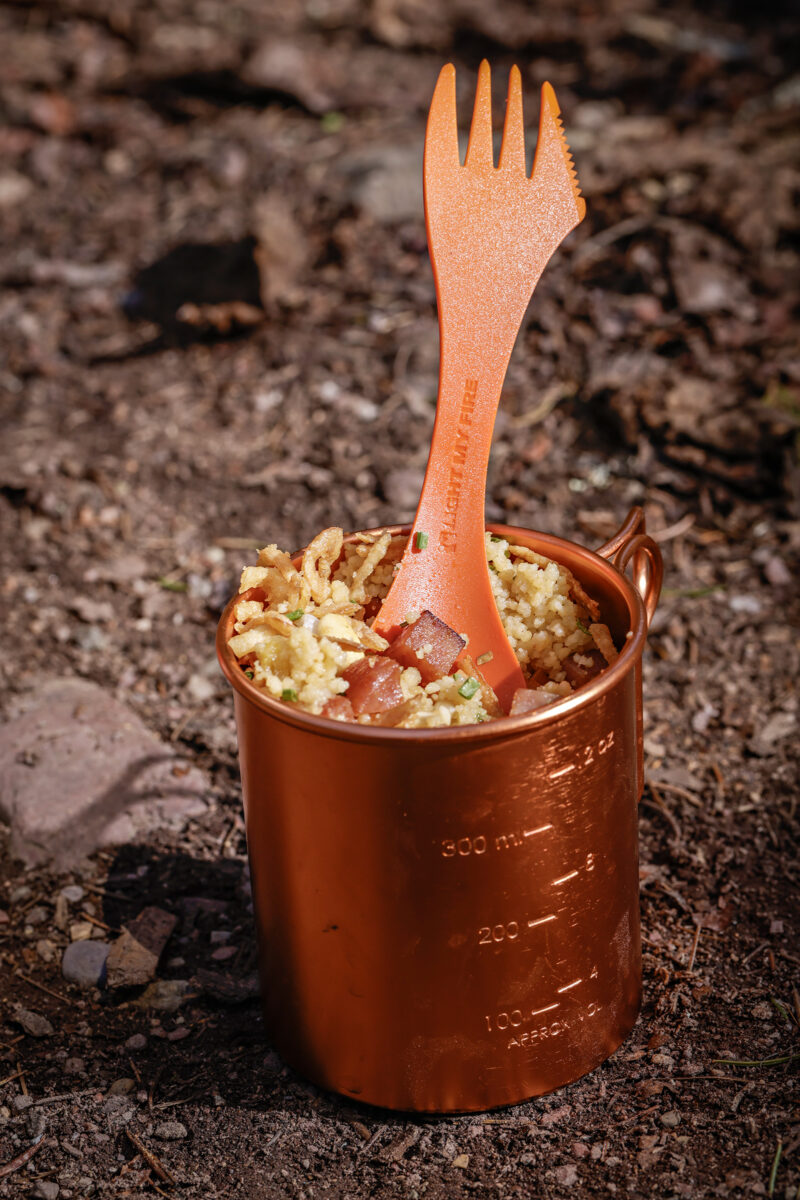
During those early years of baking and outdoor exploring, he’d sometimes just grab a loaf of bread from the bakery on his way out the door and work off that and a brick of cheese throughout the day, sometimes while sitting down and reading John Muir and Wendell Berry. There were wisps of romanticism to those experiences, he said, noting that he connected to Berry’s writings and the way they imparted beauty to the idea of labor, as well as to the natural world. But the bread-loaf days eventually went by the wayside, for at least a couple reasons. For one, Moe noted that for hardcore backpackers, baked goods are a bit of a polarizing subject given that they’re not especially nutrient dense and they take up a lot of space.
Part of what drew Moe to the world of professional cooking, and cooking instruction, was that it provided an outlet for creativity that was built upon a foundation of science-driven skills and knowledge. Which is to say, eventually, he wanted something more out of his trail meals than that loaf of bread and cheese.
During a recent weekend afternoon at a small forest campsite next to a fast-flowing creek, Moe demonstrated a trio of recipes that he’s honed over the years, including a backcountry spam and pineapple fried rice, a mushroom stock ramen made with dried morels and shiitake mushrooms, and that aforementioned quinoa chili, which is meant to be the simplest and most convenient of the three. In each case, the dishes are more backcountry homages to the real thing, rather than the textbook version of the dish itself.
With each recipe, there are some basic ideas that Moe uses to elevate and improve things, without figuratively biting off more than he can chew for a meal made with simple ingredients and limited gear.
Moe eschews super fine-tuned recipes with measurements, and believes more in transferring cooking skills that you already have to the specific environment you’re working in. If, for example, you forget an ingredient, you’re going to have to adjust on the spot, because there’s no option to run to the grocery store. Some of the uncertainty about cooking with approximate measurements can be taken out of the equation when preparing and sorting ingredients before you ever leave your house. In other cases, if you’re cooking a grain like couscous that comes in a package, you can tear off the instructions from the cardboard box and slip those into a bag with the couscous and its seasoning packet, just in case.
Moe likes to keep ingredients in separate Ziploc bags, but puts the components of meals together in individual stuff sacks. Those stuff sacks then go into a single waterproof dry bag. That helps further contain any food smells, and can be sealed with some air inside to create a protective pocket that reduces the amount of compression and crushing of food ingredients as they’re jostled about during a hike. He also packs his food stuff sacks at the top of his bag, which grants easy access, and also further protects their shape. To contain cooking liquids, Moe relies on small plastic squeeze bottles with caps, typically of the 2-ounce variety.
And yes, Moe said he worries about bears. So much so that he likes to do what he calls dinner camp, meaning he stops to cook and eat at one location, and then repacks all his food, and continues hiking for at least a half-hour more until he feels comfortable setting up a campsite for sleeping. A healthy distance from that location, maybe a few hundred yards away, he’ll put the food in a bear bag and hoist it up a tree.
As a heat source, he likes to pack an MSR backpacking PocketRocket stove, and said that you don’t necessarily have to splurge on higher-end models. He has a $40 model that works, but has also been treated very well by a $10 model. As long as it works with your cookware, and you can control the flame, you should be in good shape. Still, backpacking stoves don’t necessarily have a lot opportunity for temperature nuance when the heat is on, so it’s wise to plan for recipes that tend to involve cooking fast at high heat, which is part of what makes stir fry such a viable option given the circumstances.
In terms of cookware, it depends on the menu. For his spam and pineapple fried rice, he prefers a non-stick skillet with a size selected for how many people he’ll be cooking for at once. A 12-inch skillet is generally a good bet for cooking for two or more people, and with a lid, some skillets can even be used as a pot. Moe favors a particular skillet with sides high enough that it almost qualifies as a sauté pan. He also relies on medium-sized lidded camping pots, which he says don’t necessarily have to be nonstick.
For cooking fats, Moe prefers vegetable-based oils to butter. Oils are denser in fats, and if butter warms up enough in transit, there’s a risk that its water content separates.
One of the quickest shortcuts to improving the quality of any backcountry meal is looking for opportunities to introduce different, contrasting textures. French’s prepackaged crispy fried onions, for example, are a reliable convenience ingredient for adding texture and flavor to a range of meals, and can also double as something to snack on by itself.
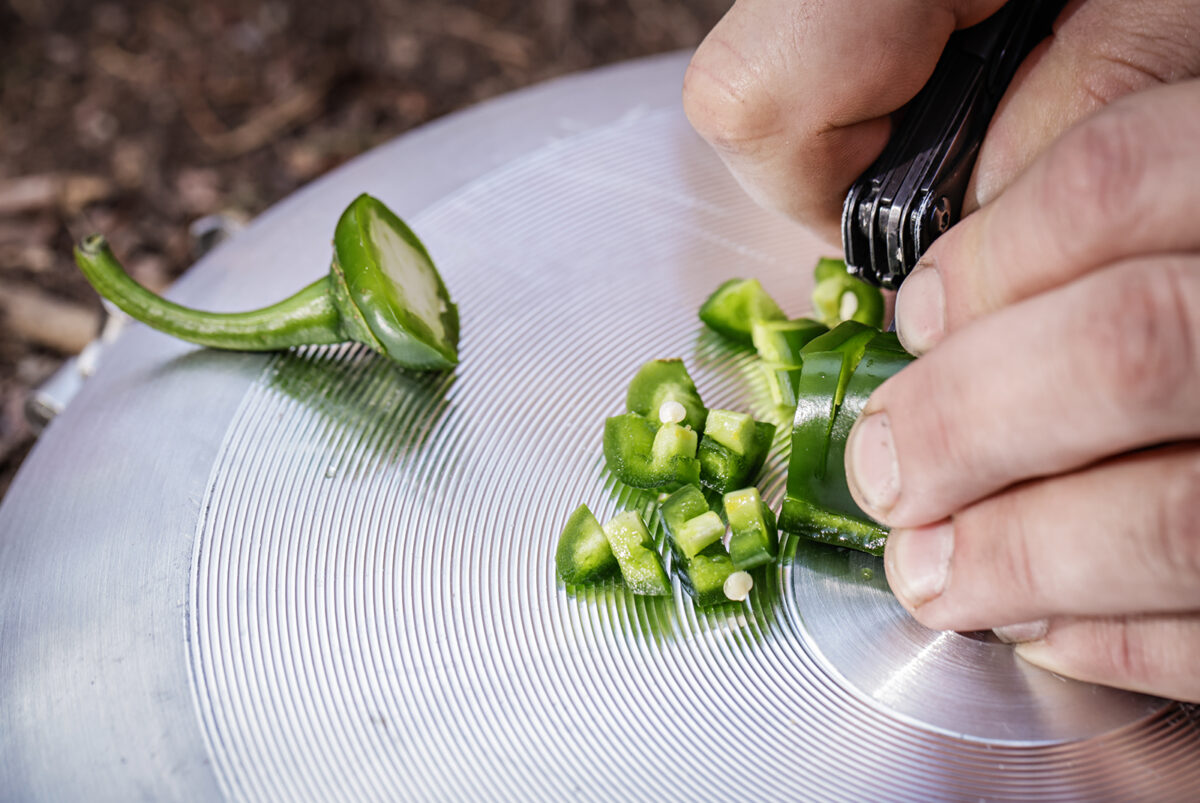
When it comes to backcountry cooking, Moe said he cares about presentation “more than most backpackers, but less than most chefs.”
If you do your research, and know what’s safe to eat, there are also opportunities to forage for ingredients during a hike, although it’s a risk to rely on foraged ingredients as a core food component since you aren’t guaranteed to find anything. Yellow avalanche lily’s, for example, have a mild, grassy flavor, which won’t drastically alter the taste of a dish, but the bright splash of color helps to improve appearance. As Moe also noted, looking for ways to forage during a hike can also be an enjoyable way to be more present and connected to the experience.
As for the core components of a recipe, a food dehydrator is a wonderful tool to have, although you can also use a regular oven to similar effect. One way to add flavor before dehydrating, is to use more flavorful cooking liquid. For the quinoa that Moe uses for his chili, he likes to cook it in chicken stock, and season it with cumin, garlic powder and salt, before he dehydrates it, but he said other combinations of flavor, like lime and cilantro, could also be incorporated depending on the recipe. When it comes to dehydrating meat, he advices to season it more heavily, since the process of rehydrating it in water can dilute flavor. Generally speaking, leaner, less fatty proteins and food items are easier to dehydrate.
For the spam and pineapple fried rice, Moe said that it’s a recipe for the first day of a backcountry trip, because he hikes with the spam and pineapple frozen (having cubed the spam and sauteed it with the pineapple at home the night before), so there’s a timetable on how soon they have to be eaten as they continue to thaw out.
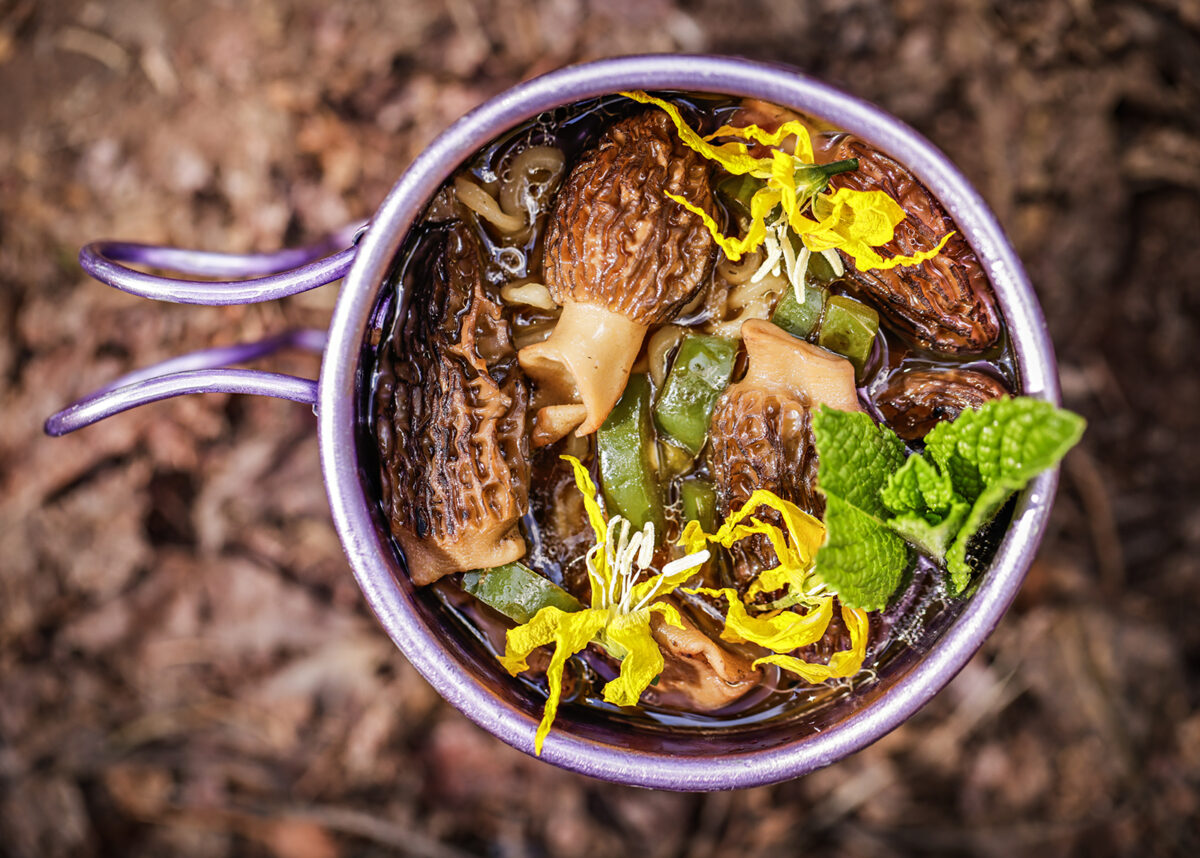
Instead of rice, he likes to bring dried couscous in enough servings to ensure everyone he’s camping with can eat plenty. He starts off with the couscous, tossing it in a camping pot, adding the seasoning packet and oil, and then water, before bringing it to a boil and taking it off the heat to sit for about five minutes, after which it needs to be fluffed with a camping spork or other utensil. Once the couscous is sitting off the heat, Moe takes a second to survey the rest of his ingredients to make sure everything’s ready, so that he can move through the steps of stir frying without interruption. In this case, he brought a carrot, so he takes a minute to dice it up with a small folding knife.
Moe then sets up the high-sided skillet over his stove and puts a thin layer of oil on its surface before adding the partially thawed pineapple and spam and cooking them with the diced carrot. He said it’s okay to be generous with the oil at different points throughout this stir fry, given that every bit you use is less you must carry the next day, and your body is likely in need of extra calories anyway. After those ingredients have warmed up, he tosses in some sliced green onion and lets it cook briefly before continuing to add more ingredients. Peanuts come next. The purpose behind adding nuts is to add texture to compensate for the inability to precisely replicate the level of crunchiness requisite in textbook fried rice.
Once the nuts start to show a little color from browning, he adds some dehydrated garlic. With the garlic, he’s waiting for it to become aromatic, before he takes all the ingredients and moves them out to the sides of the skillet. Through the circular opening he’s created, he squeezes some cooking oil from a bottle and lets it heat before adding the couscous. Traditional stir frying benefits from the smoky flavor of the wok, so in order to replicate that, Moe lets the couscous sear briefly so that it can lightly crisp. He then takes a squeeze bottle of soy sauce, squirts a generous portion over the grains in an up-and-down motion, and lets that caramelize, which adds some sweetness to the stir fry. About 15 minutes from when he started, the stir fry is ready for a generous garnish of dehydrated chives and onion crisps before it’s time to eat.
For his ramen, Moe starts by making a mushroom stock using dried shiitakes and dried morels. It’s okay if you don’t have dried morels. A couple handfuls of the dried mushrooms go into a pot filled with water, which he simmers for about four minutes to make sure everything is fully cooked, before adding a sprig or two of fresh mint leaves and a pinch of dehydrated garlic. Moe then takes the pot off the heat and covers it, letting it sit for around 20 minutes.
In this particular case, Moe has freshly foraged morels that he wants to incorporate into the ramen, but he typically doesn’t have fresh morels on hand.
To use the fresh morels, Moe starts cleaning the mushrooms he foraged that morning by covering them in water, which draws bugs and debris out. He’ll let them sit in the water for a few minutes at a time, and changes the water out a couple of times as a prelude to cooking the morels over high heat. When it comes time to cook the morels in a different pot, Moe cooks them at high heat until all the moisture has been cooked out of them, they’re no longer releasing liquid, and they’re beginning to squeak in the pot. Once they’ve browned, and the pot is drying out, he adds fat or oil into the pot, alongside some diced jalapeno. He’s looking for a little bit of crispiness and for the pot to start sizzling.

Minus the cleaning, that same cooking method is how Moe reincorporates the rehydrated mushrooms back into the stock once they’re done cooking. With the rehydrated mushrooms though, he wrings them out over the stock to try and get as much moisture out as possible, before tossing them into a separate pot to cook down. Once all mushrooms are adequately cooked, it’s time to add a couple servings of cheap, dried ramen noodles to the mushroom stock and cook them for a few minutes, as per their recommended cook time.
Once the noodles are ready, Moe adds the cooked into the pot with the stock and noodles. He then hits it with a generous squeeze (maybe a couple tablespoons) from a bottle filled with two parts soy sauce and one-part unseasoned rice vinegar. It’s a shortcut flavor combination that makes foods taste vaguely ramen-like. You can keep seasoning to taste with the soy-vinegar mixture and, if you managed to go overboard, you can dial back the flavor by adding water to the ramen. After mixing and stirring, Moe adds some freshly picked avalanche lilies for a bright splash of color, and it’s time to eat. If you enjoy furikake, a Japanese seasoning generally made with sesame seeds, dried seaweed and kelp powder, Moe said sprinkling that on top is another easy way to add flavor just before eating.
For his chili and quinoa, there are two ways to prep it. The chili component can use homemade chili, but the quickest and easiest route is to use canned chili, which Moe warms up, spreads out on a tray, and then puts into his dehydrator at home. When it’s fully dehydrated, it can be broken up into chip-like slabs and tossed into a plastic bag. As mentioned previously, Moe also cooks quinoa in a flavorful broth before dehydrating that and bagging it as well.
One method for prepping this meal for ultralight hiking involves adding the dehydrated chili and quinoa into a sealable container with some sun-dried tomato strips and dried roasted red pepper strips, before adding water, mixing and then sealing shut, and putting the mixture back into your pack while you keep hiking for another 90 minutes. All the up and down motion of the pack’s movement will rehydrate and mix everything together, but you’ll be eating the mixture cold if you choose not to reheat.
Another way to prep the meal is to mix all the components together in a pot with water and heat over a stove. Once the chili mix has warmed up and rehydrated, you can add some gluten-free cheese crisps to approximate for actual cheese, before topping it all off with something crunch and salty, like Chili Cheese Fritos.
“A lot of my choices center around, ‘How can I bring a comfort food of some sort into the backcountry?’ That’s a big thing, especially if I’m cooking for other people,” Moe said.
In the backcountry, the ambiance can’t be controlled, but there is a sense of peace, and so the food should play to that.
It should, Moe said, feel something like home.
You can book Dan Moe as a backcountry chef by contacting him at [email protected]. He also regularly teaches cooking classes at Trovare in Whitefish. This summer he’ll be launching a new bagel-making business in July, called Cutthroat Bagels, which you can find at farmer’s markets in Columbia Falls and Kalispell.